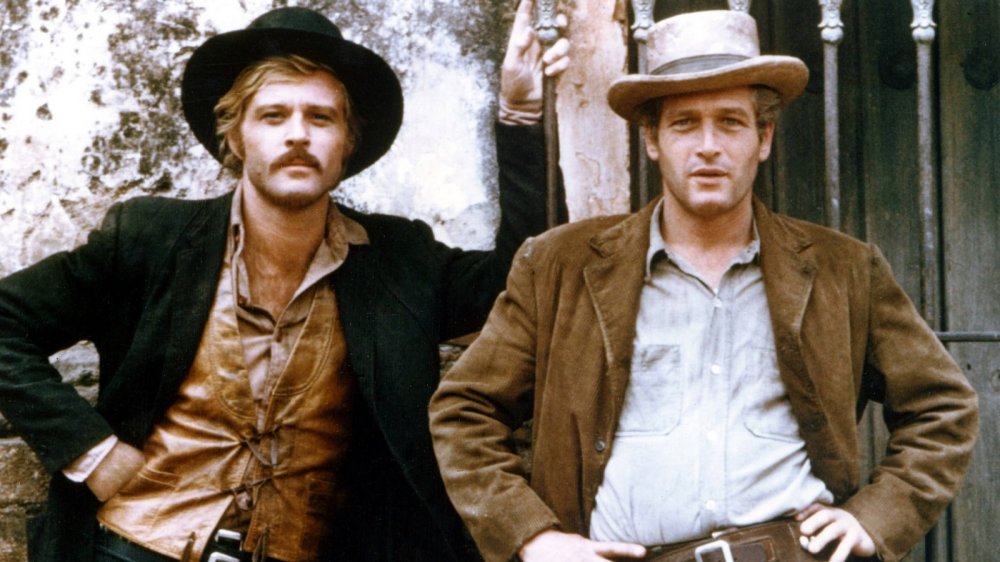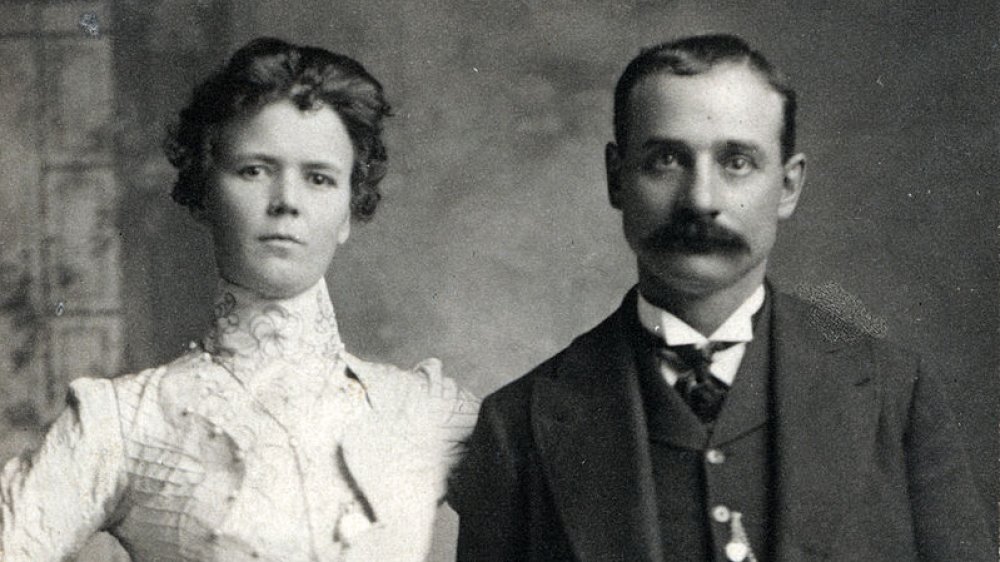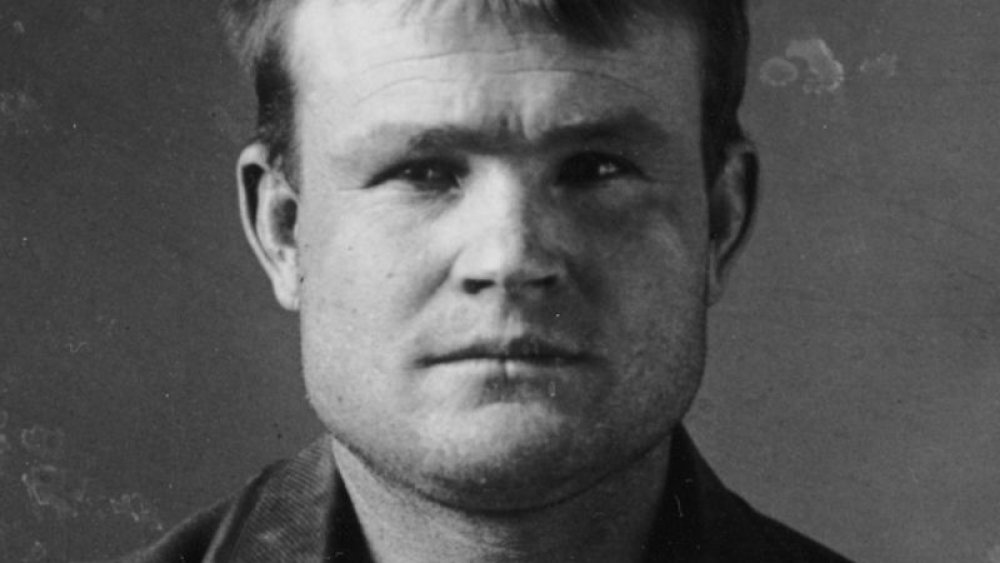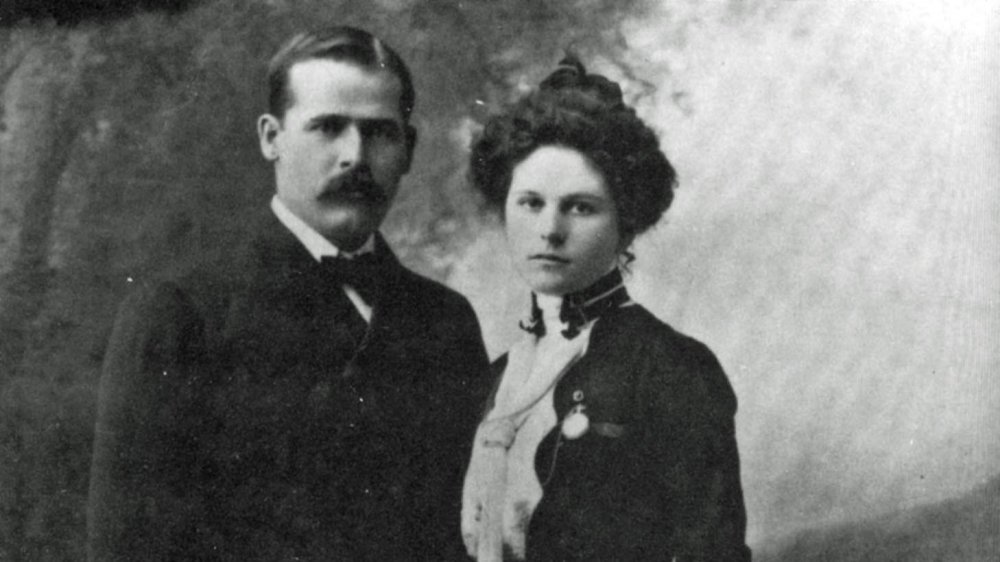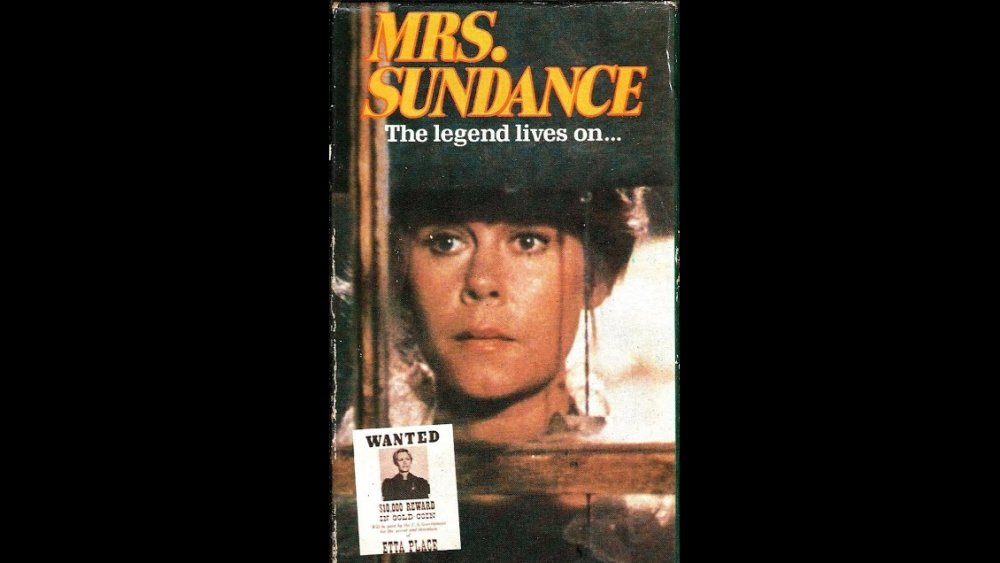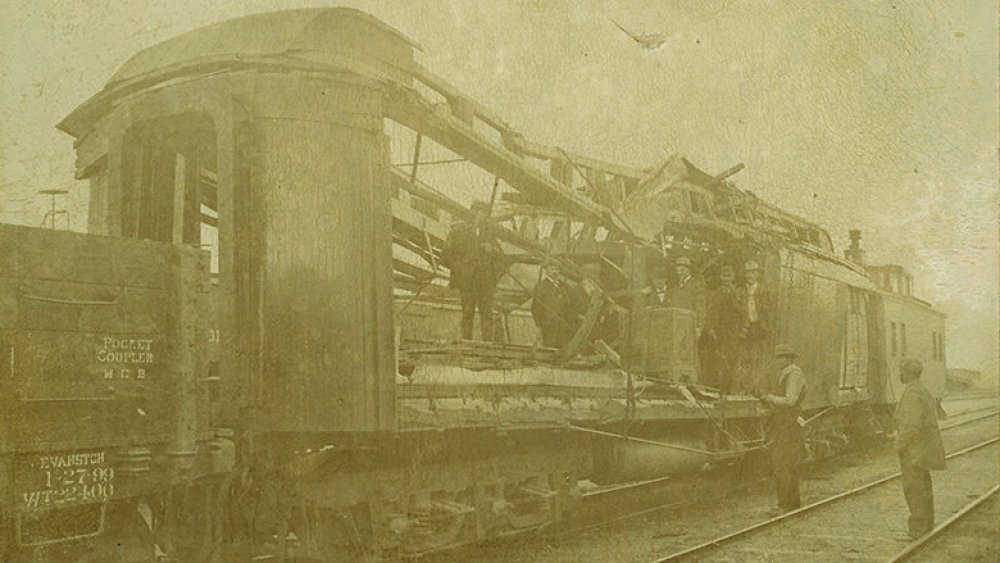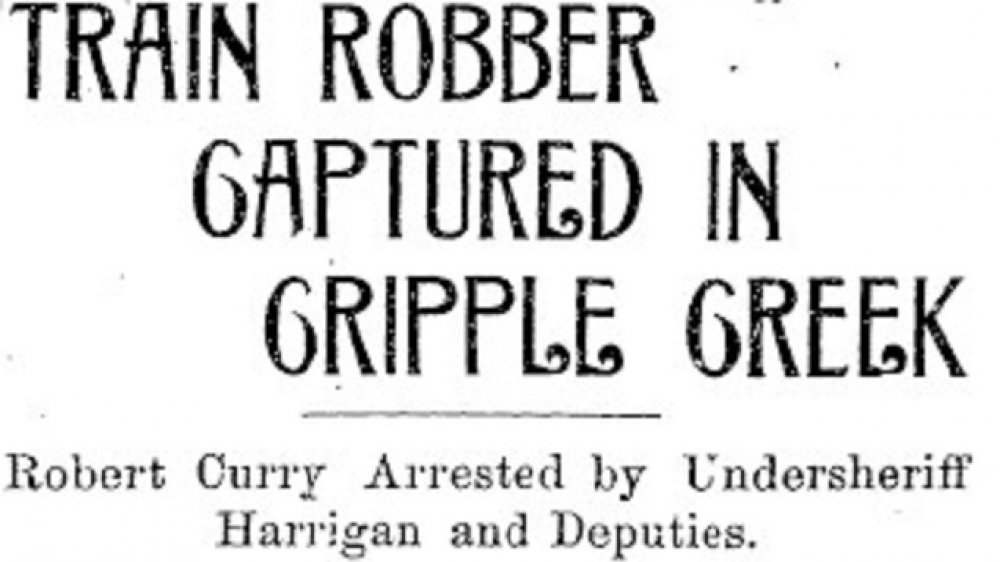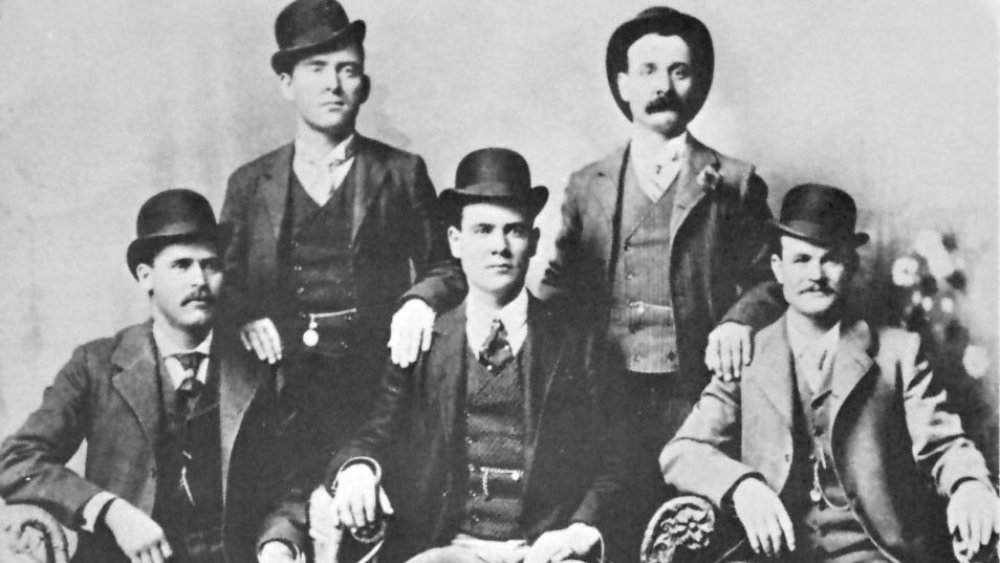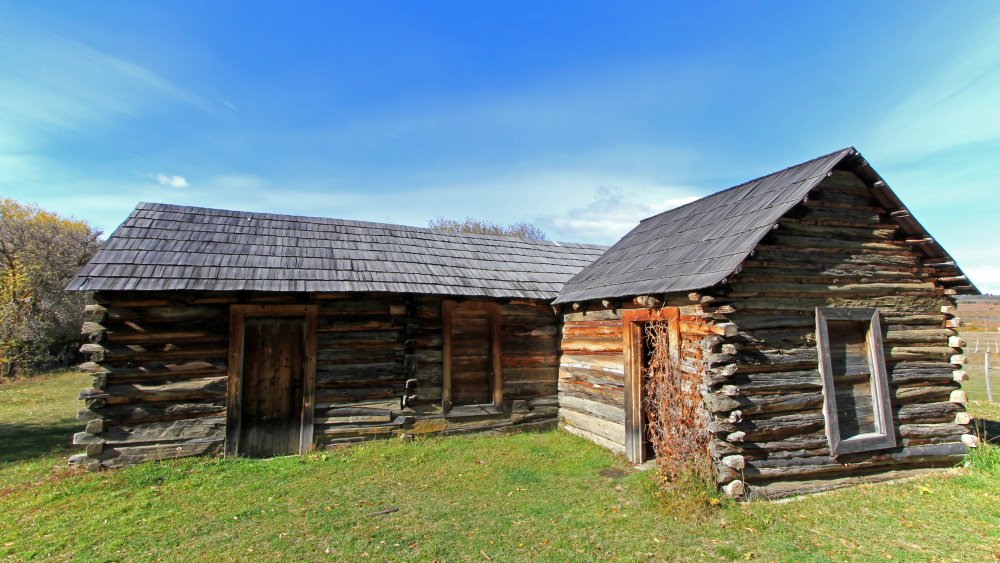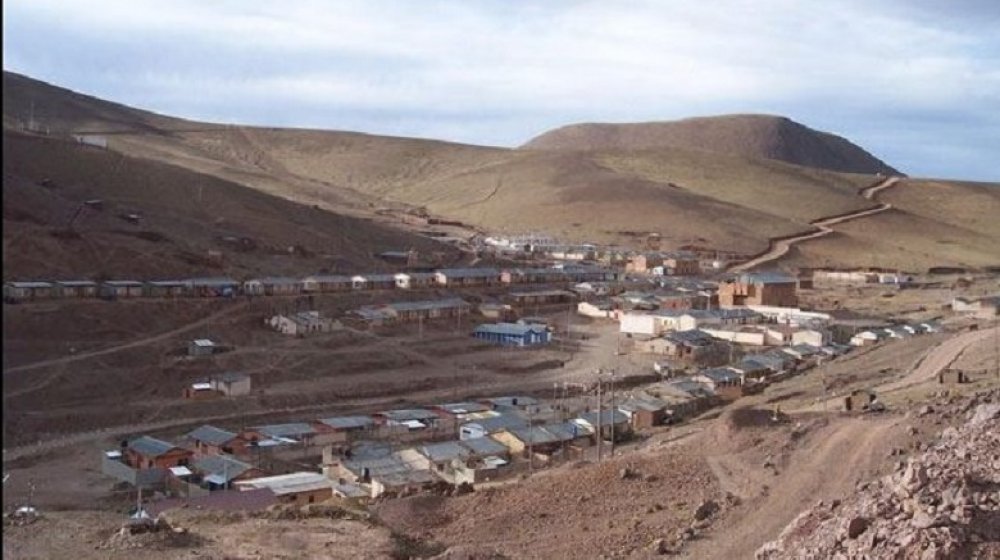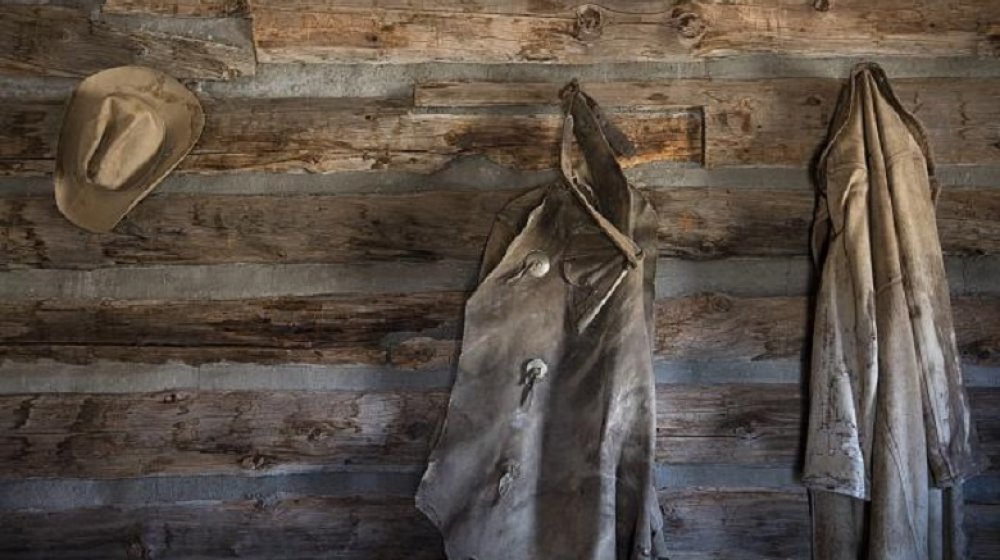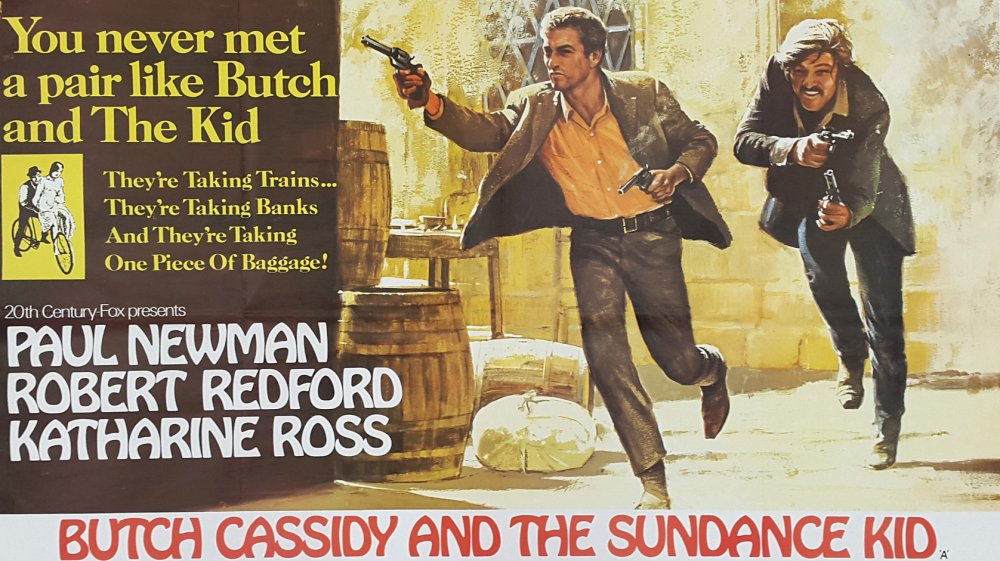The Mysterious Lives Of Butch Cassidy And The Sundance Kid
We may receive a commission on purchases made from links.
No other outlaws charmed the Old West quite like Butch Cassidy and the Sundance Kid. The two men came from diverse backgrounds: Cassidy was raised as Robert LeRoy Parker at his Mormon family's ranch in Utah. Harry Longabaugh, alias the Sundance Kid, came from Pennsylvania. Neither outlaw claimed the other as his partner, but the two were somehow thrown together.
The pair met during their stint with the Wild Bunch, a transient group of criminals credited with numerous train and bank robberies around the turn of the last century. Members of the Wild Bunch were comprised of unemployed cowboys, misfits, outlaws, and others who favored hanging out at their hideout, a place called Hole-in-the-Wall, in a remote section of Wyoming (per Atlas Obscura). According to TheWildWest.org, Cassidy often led his own Hole-in-the-Wall Gang on numerous illegal escapades, while Sundance tended to come and go as he pleased.
But then law enforcement decided to put a stop to their outlaw ways and break up the Wild Bunch—permanently. Cassidy and Sundance fled to Bolivia together. Nobody knows for sure exactly what became of them or where they died (although that didn't stop Hollywood from making a classic film about it.) Several legendary tales have created a history mystery quite unlike any other.
Who were the members of the Wild Bunch?
The true number of Wild Bunch members is unknown. Some of the better-known outlaws from the gang, according to Spartacus Educational Ltd., included Cassidy and Sundance, but also Will Carver, Ben the "Tall Texan" Kilpatrick, Elzy Lay, Bob Lee, Lonnie Logan, Harvey "Kid Curry" Logan (pictured with girlfriend Annie Rogers), Flat-Nose Curry, Matt Warner and many others. Some were married, some were single. Many of them were simply outcasts, forced by one incident or another to step over the lines of the law. Within the confines of their many hideouts, they found acceptance among each other, as well as a forum for their varied talents.
With or without the gang, each member of the Wild Bunch had a gentlemen's agreement to never betray one another. Under Butch Cassidy's tutelage, the gang was rarely violent. Writer Jack Adler is just one of many authors to repeat the tale that the outlaws were instructed to shoot at the horses, not the riders, if the gang was pursued by a posse. According to a Pinkerton's report in 1924, the Wild Bunch "committed few murders in comparison to their great number of bold crimes. Their code must have been higher [than that] of the low-class criminal of today, who kills on sight and gets away with motor [cars]." At any given time, various members of the gang could be found lounging around at Hole in the Wall, or Robber's Roost—another hideout in Utah.
Butch Cassidy: The gentleman bandit
Because of his family ties and his reputation as a robber rather than a killer, Butch Cassidy especially was able to retain relationships with "respectable" folks. Trusting, upstanding citizens who knew him were known to participate in horse races at Wild Bunch hideouts. According to Cassidy's sister, Lula Betenson, Cassidy came from a respectable Mormon family and had a number of honorable friends scattered throughout the west. Often, proceeds from the robberies Cassidy took part in went to needy families, earning him the title of the "Robin Hood of the West." In return for his generosity and compassion, Cassidy's friends were willing to put him up, feed him on the run, finance his escapes, and lie about his whereabouts.
Even law officers liked Cassidy. In his book, Butch Cassidy: Beyond the Grave, W.C. Jameson recounts the time the outlaw was sentenced to prison for stealing a horse in Wyoming during 1894. When Constable Henry Boedeker was asked why Cassidy wasn't shackled with the other prisoners, he responded that the outlaw was the only one who could be trusted. Indeed, Cassidy was a model prisoner. Eighteen months into his sentence, he met with Governor W.A. Richards to discuss early parole. Although Cassidy told Richards he was far more interested in robbing banks than stealing horses, the governor released him anyway—upon a promise from Cassidy that he would leave Wyoming banks alone. According to Butch Cassidy biographer Richard M. Patterson, the young outlaw kept his promise.
The Sundance Kid: A reckless outlaw
An excellent marksman, the Sundance Kid sported a more reckless reputation than his easy-going counterpart. In about 1882, the 15-year-old headed west with his cousin in a covered wagon, according to writer Neil Patrick. The would-robber was arrested for the first and only time in 1887 for horse stealing and served two years for the crime at Sundance, Wyoming. The young outlaw took his new moniker from the town where he served his time. Upon his release in 1889, the young cowpoke took an honest job breaking horses for the historic Bar U Ranch in Alberta, Canada (per Canada Cool). In 1892, however, the Sundance Kid was named a suspect following an 1892 train robbery at Malta, Montana.
According to Biography, the Sundance Kid met Harvey Logan in 1897, and the two robbed a bank in Belle Fouche, South Dakota. Both were captured and jailed in Deadwood, but were able to escape. Eventually, Logan introduced Sundance to Butch Cassidy, and he officially joined up with the Wild Bunch. But as much as Sundance sported a reputation as a gunfighter, Neil Patrick and other sources confirm that as far as anyone knows, he never killed anyone during his time with the Wild Bunch. Rather, Sundance preferred the persona of a dapper-dan who was a favorite of the ladies. It is he who kept company with an equally refined woman, the mysterious Etta Place (pictured here with Sundance) who accompanied he and Butch Cassidy to Bolivia.
A mysterious femme: Etta Place
As romantic sounding as her moniker is, Etta Place (shown here as portrayed by Elizabeth Montgomery in the 1974 movie Mrs. Sundance) was not the lady's real name. According to Cassidy and Sundance researcher Anne Meadows, Pinkerton's earliest documentation about Place identified her first name as Ethel, Etta, Eva and Rita. There are numerous theories as to her origins. In her book, The Wild Bunch at Robber's Roost, author Pearl Baker wrote that Etta Place was the only second woman to appear at Robber's Roost in 1896. Baker also said Place was Butch Cassidy's girlfriend first before falling for Sundance, although some dispute this.
Other historians have said the woman at the hideout was not Place at all, but someone else. The real Etta Place, according to Pinkerton's (per author James D. Horan) claimed Cassidy and Sundance met Place at Fannie Porter's brothel in San Antonio, Texas. Because Pinkerton's believed the story was true, historians believed it too. But Place fails to appear in any documents related to Fannie Porter, and dogged research by authors like Donna Ernst (who married into the lineage of the Sundance Kid) has failed to turn up any hard evidence. All that is known for sure is that the genteel lady fell hard enough for the Sundance Kid to risk fleeing from the law with him to South America. Etta Place's story, or lack thereof, is a fascinating addition to the outlaws' tale.
The train robbery at Wilcox, Wyoming
In the movie, Butch Cassidy and the Sundance Kid, a rather comical scene depicts Wild Bunch members accidentally blowing a train car to smithereens. As wood and metal fly through the air, Sundance quips, "Think you used enough dynamite there, Butch?" The scene immortalizes the infamous robbery of a Union Pacific train near Wilcox, Wyoming on June 2, 1899. Among those newspapers to report the incident was the Telluride Daily Journal in Colorado, where a young Cassidy Cassidy had robbed his first bank back in 1889. Authorities scrambled to find the culprits as Cassidy, Sundance, and their cohorts scattered in all directions. But it was not until October that Cassidy and his buddies were even identified as the robbers.
It would be two more years before authorities could put their finger on any of the bandits. Following dozens of leads, Pinkerton's and other detectives looked everywhere for the elusive robbers. Finally, the men found what they were looking for in the way of "Lewis" Curry, aka Lonny Logan, whom they tracked to a small town in Kansas. Logan was killed while trying to escape, but the lawmen also found another important clue: the robber had recently been in Cripple Creek, Colorado with a man identified as Bob Curry, better known as Robert Lee. The Cripple Creek Morning Times verified that both men had been involved in the Wilcox Robbery, and both men likely knew the whereabouts of Butch Cassidy and the Sundance Kid.
The beginning of the end for Butch Cassidy and the Sundance Kid
Officers notified the Cripple Creek sheriff to find and arrest Bob Lee, a cousin to Harvey and Lonny Logan. When Lee was found, he was dealing a game of stud poker at the Antlers Saloon. Undersheriff Harrington approached the man and asked if his name was Bob Lee, to which Lee responded, "What is it to you?" Harrington answered, "Well never mind, you're the man I want. You are under arrest." Lee claimed he wasn't armed, but when they searched him, sure enough, Lee was carrying a "huge pearl-handled six-shooter." On the way to jail, Lee asked if he was being arrested for gambling several times. When he learned he was wanted for the Wilcox train robbery, he "shut up like a clam."
Lee was extradited to Wyoming, where his trial was set for May. Although noted Cripple Creek attorney J. Maurice Finn defended him, the 1900 census verifies Lee as a prisoner at the Wyoming State Penitentiary in Laramie, where he was serving 10 years for his participation in the Wilcox affair. Two years after he was released, Lee's death certificate verifies he passed away from Bright's Disease at just 45. Lee never implicated Cassidy and Sundance in the robbery, and besides, Cassidy had previously promised to stay out of Wyoming. But the Pinkerton's Agency, angered over the Wilcox robbery and tired of the Wild Bunch's antics, set out for Cassidy and Sundance with a vengeance.
Pinkertons hunt down the Wild Bunch
As Bob Lee went through the wringer over the Wilcox robbery, others of the Wild Bunch were having a high time. On November 21, 1900, according to author Donna Ernst, Sundance, Cassidy, Will Carver, Ben Kilpatrick and Harvey Logan had their portrait taken at a photography studio in Fort Worth, Texas. Wells, Fargo & Company detective Fred J. Dodge saw the image, recognized Will Carver, and sent a copy to Pinkerton's Detective Agency. Shortly afterwards, says Anne Meadows, Sundance took Etta Place to New Orleans to celebrate the New Year before the couple traveled to Pennsylvania to meet Sundance's family. The twosome next went to New York, where they saw a doctor for some unknown ailment and joined up with Cassidy, according to biographer Richard Patterson.
During their time in New York, Cassidy, Sundance and Place used various aliases as they spent three weeks seeing the sights. At Tiffany & Co., Sundance bought a fancy lapel watch for Place, as well as a gold watch for himself. More telling to Pinkerton's was the only known photograph of Place, with Sundance, that was taken at DeYoung Photography Studio. Just a few days later, Sundance and Place (and perhaps Cassidy) were believed to have boarded the SS Herminius for Buenos Aires, per Donna Ernst. Anne Meadows also found that Sundance and Place checked into the Hotel Europa upon their arrival, and that Sundance opened a bank account amounting to about $12,000.
Butch Cassidy and the Sundance Kid flee to Bolivia
Writer Jack Epstein, in the Christian Science Monitor, states that soon after their arrival in Bolivia, Cassidy, Sundance and Place traveled to Argentina. There, they purchased a 12,000 acre ranch in the Cholila Valley. Cassidy purchased cattle, sheep and horses, and built a cozy cabin for the three to live in. Neighbors recalled liking the threesome, noting they were "law-abiding citizens." Historians Anne Meadows and Daniel Buck both visited the cabin during the 1990s and were told by others that Place set her table "with a certain etiquette" that included "napkins [and] china plates," also that the cabin was simply but elegantly appointed with burgundy-and-gold brocade wallpaper.
Cassidy now went by James Ryan, while Sundance and Etta masqueraded as Mr. and Mrs. Harry Place. Their aliases would change over time, especially when the three returned to robbing banks in about 1904. Several robberies were attributed to Cassidy and Sundance, sometimes accompanied by Place. Soon, wanted posters were appearing throughout South America looking for the "bandidos yanqui," wrote Donna Ernst. But Place must have sensed some uneasiness about remaining in South America, for she traveled back and forth to the United States at least four times. The last time was in 1905, when Sundance indicated in a letter to his friend, Dan Gibbon, that he was taking his "wife" to San Francisco. It was the last time anyone would hear any official news about the mysterious Etta Place.
Did Butch and Sundance die in Bolivia?
History reports that on November 4, 1908 Carlos Pero, courier for a Bolivian mine, was accosted by two Anglo men wearing bandannas over their faces. The pair relieved Pero of the payroll he carried and disappeared. Authorities were notified and headed to the village of San Vicente (pictured), where two men had been identified per Pero's description of the robbers. When a soldier approached a house where the bandits were hiding, he was shot dead. In the ensuing gun battle, Mayor Cleto Bellot remembered hearing screams inside the house, then two shots in succession. Lawmen entered the house and found the bandits, who appeared to have committed a murder-suicide.
On their visit to San Vicente, Anne Meadows and Daniel Buck were told by a local, Senor Risso, that about twenty soldiers were on the scene of the shootout. After the shootout, "The corpses were laid out in the patio and later buried in the cemetery." The trouble was, the men were only assumed to be Butch Cassidy and the Sundance Kid. "How did that rumor get started?" posed writer Steven Law for KSL.com in Utah. Law believed Lula Betenson's story that the duo's friend, Percy Seibert, purposely started the story that Cassidy and Sundance had been killed so that the outlaws could "go straight" without further interference from the law. Soon afterwards, stories began circulating that the outlaws had returned to the United States.
Did Butch Cassidy and the Sundance Kid come home?
For years, numerous people claimed to have seen Cassidy, or Sundance, or both (and sometimes Place) after 1908. Wyoming Tales and Trails reports that one of the earliest claims came from Milton David Hinkle, who said he saw Cassidy and Sundance in Argentina in 1909 and again in 1913. Anne Meadows gives citations of additional sightings reported in 1910, 1915, and 1918. Author C.F. Eckhardt said there were "historical indications" that Cassidy managed a ranch in New Mexico in the late 1920s. The stories went on and on.
The most believable tale of those claiming to have seen Cassidy came from members of his own family. Cassidy's nephew, Bill Betenson, claimed there were roughly twenty "well-documented" sightings over the years. According to Biography, Betenson also supported his mother Lula's claim that the outlaw came home in 1925 and spent time with the family. Lula said Cassidy died in 1937, a date which jives of with the death of William T. Phillips who claimed he actually was Butch Cassidy. Lula didn't believe him, but Phillips told his story in an unpublished novella, Bandit Invincible: The Story of Butch Cassidy and achieved national fame. "Total horse pucky," said Daniel Buck in an NBC article written about the matter in 2011. "It [the novella] doesn't bear a great deal of relationship to Butch Cassidy's real life, or Butch Cassidy's life as we know it."
Butch Cassidy and the Sundance Kid: The Movie
The debates about whether Butch Cassidy and the Sundance Kid really died in 1908 likely would be less famous were it not for the classic film Butch Cassidy and the Sundance Kid. Released in 1969, the film won four Oscars and was nominated for best picture, according to IMDB. The film also catapulted actors Paul Newman (as Cassidy) and Robert Redford (as Sundance) to stardom. Actress Katharine Ross, who played the beautiful and refined Etta Place, later remembered, "I don't really know how I got the part. I didn't audition. Maybe the producers wanted me at that moment."
Most tantalizing to audiences was a disclaimer in the opening credits of the film reading, "Most of what follows is true." The statement intrigued numerous historians and history buffs nationwide as the movie made over $100 million in box-office sales. In the years since the movie was released, dozens upon dozens of books and articles have been written about Butch Cassidy, the Sundance Kid, Etta Place, the Hole-in-the-Wall Gang, and the Wild Bunch, as well as the group's other members. Although hundreds of new clues and evidence has surfaced regarding the deaths of Cassidy and Sundance, no solid conclusions have been reached. In life, the outlaws eluded the law with finesse. And in death, the elusive pair has managed to give history the slip.
